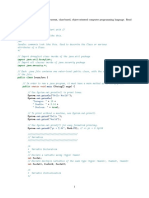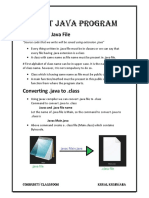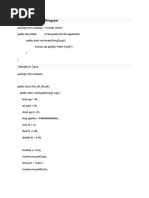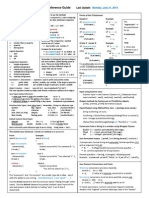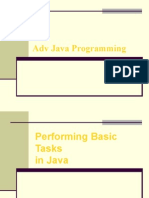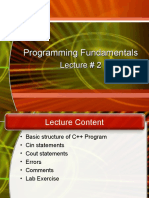Java Cheatsheet _ CodeWithHarry
Uploaded by
tim.schurtenbergerJava Cheatsheet _ CodeWithHarry
Uploaded by
tim.schurtenbergerJava Cheatsheet | CodeWithHarry https://www.codewithharry.
com/blogpost/java-cheatsheet/
</> CodeWithHarry Menu Login
Java Cheatsheet
Haris Ali Khan
January 4, 2023 15 min read
Basics
Basic syntax and functions from the Java programming language.
Boilerplate
class HelloWorld
{
public static void main(String args[])
{
System.out.println("Hello World");
}
}
Showing Output
It will print something to the output console.
class HelloWorld
{
public static void main(String args[])
{
System.out.println("Hello World");
}
}
1 von 41 28/11/2024, 17:49
Java Cheatsheet | CodeWithHarry https://www.codewithharry.com/blogpost/java-cheatsheet/
Taking Input
It will take string input from the user
import java.util.Scanner;
class HelloWorld
{
public static void main(String args[])
{
Scannner sc=new Scanner(System.in);
String name=sc.nextLine();
System.out.println(name);
}
}
It will take integer input from the user
import java.util.Scanner;
class HelloWorld
{
public static void main(String args[])
{
Scannner sc=new Scanner(System.in);
int x=sc.nextInt();
System.out.println(x);
}
}
It will take float input from the user
import java.util.Scanner;
class HelloWorld
{
public static void main(String args[])
{
Scannner sc=new Scanner(System.in);
int x=sc.nextFloat();
System.out.println(x);
}
2 von 41 28/11/2024, 17:49
Java Cheatsheet | CodeWithHarry https://www.codewithharry.com/blogpost/java-cheatsheet/
It will take double input from the user
import java.util.Scanner;
class HelloWorld
{
public static void main(String args[])
{
Scannner sc=new Scanner(System.in);
double x=sc.nextDouble();
System.out.println(x);
}
}
Primitive Type Variables
The eight primitives defined in Java are int, byte, short, long, float, double,
boolean, and char those aren't considered objects and represent raw values.
byte
byte is a primitive data type it only takes up 8 bits of memory.
class HelloWorld
{
public static void main(String args[])
{
byte age=18;
System.out.println(age);
}
}
long
long is another primitive data type related to integers. long takes up 64 bits of
memory.
3 von 41 28/11/2024, 17:49
Java Cheatsheet | CodeWithHarry https://www.codewithharry.com/blogpost/java-cheatsheet/
class HelloWorld
{
public static void main(String args[])
{
long var=900.0;
System.out.println(age);
}
}
float
We represent basic fractional numbers in Java using the float type. This is a
single-precision decimal number. Which means if we get past six decimal
points, this number becomes less precise and more of an estimate.
class HelloWorld
{
public static void main(String args[])
{
float price=100.05;
System.out.println(price);
}
}
char
Char is a 16-bit integer representing a Unicode-encoded character.
class HelloWorld
{
public static void main(String args[])
{
char letter='A';
System.out.println(letter);
}
}
4 von 41 28/11/2024, 17:49
Java Cheatsheet | CodeWithHarry https://www.codewithharry.com/blogpost/java-cheatsheet/
int
int holds a wide range of non-fractional number values.
class HelloWorld
{
public static void main(String args[])
{
int var1=256;
System.out.println(var1);
}
}
short
If we want to save memory and byte is too small, we can use short.
class HelloWorld
{
public static void main(String args[])
{
short var2=5666;
System.out.println(var2);
}
}
Comments
A comment is the code that is not executed by the compiler, and the
programmer uses it to keep track of the code.
Single line comment
// It's a single line comment
Multi-line comment
5 von 41 28/11/2024, 17:49
Java Cheatsheet | CodeWithHarry https://www.codewithharry.com/blogpost/java-cheatsheet/
/* It's a
multi-line
comment
*/
Constants
Constants are like a variable, except that their value never changes during
program execution.
public class Declaration {
final double PI = 3.14;
public static void main(String[] args) {
System.out.println("Value of PI: " + PI);
}
}
Arithmetic Expressions
These are the collection of literals and arithmetic operators.
Addition
It can be used to add two numbers
public class HelloWorld
{
public static void main(String args[])
{
int x=10+3;
System.out.println(x);
}
}
6 von 41 28/11/2024, 17:49
Java Cheatsheet | CodeWithHarry https://www.codewithharry.com/blogpost/java-cheatsheet/
Subtraction
It can be used to subtract two numbers
public class HelloWorld
{
public static void main(String args[])
{
int x=10-3;
System.out.println(x);
}
}
Multiplication
It can be used to multiply add two numbers
public class HelloWorld
{
public static void main(String args[])
{
int x=10*3;
System.out.println(x);
}
}
Division
It can be used to divide two numbers
7 von 41 28/11/2024, 17:49
Java Cheatsheet | CodeWithHarry https://www.codewithharry.com/blogpost/java-cheatsheet/
public class HelloWorld
{
public static void main(String args[])
{
int x=10/3;
System.out.println(x);
}
}
Modulo Remainder
It returns the remainder of the two numbers after division
public class HelloWorld
{
public static void main(String args[])
{
int x=10%3;
System.out.println(x);
}
}
Augmented Operators
Addition assignment
public class HelloWorld
{
public static void main(String args[])
{
var=1;
var+=10;
System.out.println(var);
}
}
8 von 41 28/11/2024, 17:49
Java Cheatsheet | CodeWithHarry https://www.codewithharry.com/blogpost/java-cheatsheet/
Subtraction assignment
public class HelloWorld
{
public static void main(String args[])
{
var=1;
var-=10;
System.out.println(var);
}
}
Multiplication assignment
public class HelloWorld
{
public static void main(String args[])
{
var=1;
var*=10;
System.out.println(var);
}
}
Division assignment
public class HelloWorld
{
public static void main(String args[])
{
var=1;
var/=10;
System.out.println(var);
}
}
9 von 41 28/11/2024, 17:49
Java Cheatsheet | CodeWithHarry https://www.codewithharry.com/blogpost/java-cheatsheet/
Modulus assignment
public class HelloWorld
{
public static void main(String args[])
{
var=1;
var%=10;
System.out.println(var);
}
}
Escape Sequences
It is a sequence of characters starting with a backslash, and it doesn't
represent itself when used inside string literal.
Tab
It gives a tab space
public class HelloWorld
{
public static void main(String args[])
{
System.out.print("\t");
}
}
Backslash
It adds a backslash
public class HelloWorld
{
public static void main(String args[])
{
10 von 41 28/11/2024, 17:49
Java Cheatsheet | CodeWithHarry https://www.codewithharry.com/blogpost/java-cheatsheet/
System.out.print("\\");
}
}
Single quote
It adds a single quotation mark
public class HelloWorld
{
public static void main(String args[])
{
System.out.print("\'");
}
}
Question mark
It adds a question mark
public class HelloWorld
{
public static void main(String args[])
{
System.out.print("\?");
}
}
Carriage return
Inserts a carriage return in the text at this point.
public class HelloWorld
{
public static void main(String args[])
{
System.out.print("\r");
11 von 41 28/11/2024, 17:49
Java Cheatsheet | CodeWithHarry https://www.codewithharry.com/blogpost/java-cheatsheet/
}
}
Double quote
It adds a double quotation mark
public class HelloWorld
{
public static void main(String args[])
{
System.out.print("\"");
}
}
Type Casting
Type Casting is a process of converting one data type into another
Widening Type Casting
It means converting a lower data type into a higher
class HelloWorld
{
public static void main(String args[])
{
int x = 45;
double var_name = x;
System.out.println(var_name);
}
Narrowing Type Casting
It means converting a higher data type into a lower
12 von 41 28/11/2024, 17:49
Java Cheatsheet | CodeWithHarry https://www.codewithharry.com/blogpost/java-cheatsheet/
class HelloWorld
{
public static void main(String args[])
{
double x = 40005;
int var_name = x;
System.out.println(var_name);
}
Decision Control Statements
Conditional statements are used to perform operations based on some
condition.
if Statement
if (condition) {
// block of code to be executed if the condition is true
}
if-else Statement
if (condition) {
// If condition is True then this block will get executed
} else {
// If condition is False then this block will get executed
}
if else-if Statement
if (condition1) {
// Codes
13 von 41 28/11/2024, 17:49
Java Cheatsheet | CodeWithHarry https://www.codewithharry.com/blogpost/java-cheatsheet/
}
else if(condition2) {
// Codes
}
else if (condition3) {
// Codes
}
else {
// Codes
}
Ternary Operator
It is shorthand of an if-else statement.
Syntax
variable = (condition) ? expressionTrue : expressionFalse;
Example
public class TernaryOperatorExample
{
public static void main(String args[])
{
int x, y;
x = 20;
y = (x == 1) ? 61: 90;
System.out.println("Value of y is: " + y);
y = (x == 20) ? 61: 90;
System.out.println("Value of y is: " + y);
}
}
Switch Statements
14 von 41 28/11/2024, 17:49
Java Cheatsheet | CodeWithHarry https://www.codewithharry.com/blogpost/java-cheatsheet/
It allows a variable to be tested for equality against a list of values (cases).
class SwitchExample
{
public static void main(String args[])
{
int day = 4;
switch (day) {
case 1:
System.out.println("Monday");
break;
case 2:
System.out.println("Tuesday");
break;
case 3:
System.out.println("Wednesday");
break;
case 4:
System.out.println("Thursday");
break;
5
Iterative Statements
Iterative statements facilitate programmers to execute any block of code
lines repeatedly and can be controlled as per conditions added by the coder.
while Loop
It iterates the block of code as long as a specified condition is True
public class WhileExample
{
public static void main(String[] args)
{
int i=1;
while(i<=10)
{
System.out.println(i);
i++;
}
15 von 41 28/11/2024, 17:49
Java Cheatsheet | CodeWithHarry https://www.codewithharry.com/blogpost/java-cheatsheet/
}
}
for Loop
for loop is used to run a block of code several times
class HelloWorld
{
public static void main(String args[])
{
int i;
for(i=1;i<100;i++)
{
System.out.println(i);
}
}
for-each Loop
public class HelloWorld
{
public static void main(String args[])
{
int[] arr = {2,4,5,7,8,0,3,5}
for (int i : arr) {
System.out.println(i);
}
}
do-while Loop
It is an exit controlled loop. It is very similar to the while loop with one
difference, i.e., the body of the do-while loop is executed at least once even if
16 von 41 28/11/2024, 17:49
Java Cheatsheet | CodeWithHarry https://www.codewithharry.com/blogpost/java-cheatsheet/
the condition is False
public class HelloWorld
{
public static void main(String args[])
{
int i=1;
do
{
System.out.println(i);
i++;
}while(i<=100);
}
}
Break statement
break keyword inside the loop is used to terminate the loop
class HelloWorld
{
public static void main(String args[])
{
int i;
for(i=1;i<100;i++)
{
System.out.println(i);
if(i==50)
break;
}
}
Continue statement
continue keyword skips the rest of the current iteration of the loop and returns
to the starting point of the loop
17 von 41 28/11/2024, 17:49
Java Cheatsheet | CodeWithHarry https://www.codewithharry.com/blogpost/java-cheatsheet/
class HelloWorld
{
public static void main(String args[])
{
int i;
for(i=1;i<100;i++)
{
System.out.println(i);
if(i==50)
continue;
}
}
Arrays
Arrays are used to store multiple values in a single variable
Declaring an array
Declaration of an array
public class HelloWorld
{
public static void main(String args[])
{
String [] var_name;
}
}
Defining an array
Defining an array
public class HelloWorld
{
public static void main(String args[])
18 von 41 28/11/2024, 17:49
Java Cheatsheet | CodeWithHarry https://www.codewithharry.com/blogpost/java-cheatsheet/
{
String [] var_name={"harry","rohan","aakash"}
}
}
Accessing an array
Accessing the elements of an array
public class HelloWorld
{
public static void main(String args[])
{
String[] var_name = {''Harry", "Rohan", "Aakash"};
System.out.println(var_name[index]);
}
}
Changing an element
Changing any element in an array
public class HelloWorld
{
public static void main(String args[])
{
String[] var_name = {''Harry", "Rohan", "Aakash"};
var_name[2]="Shubham";
}
}
Array length
It gives the length of the array
public class HelloWorld
{
19 von 41 28/11/2024, 17:49
Java Cheatsheet | CodeWithHarry https://www.codewithharry.com/blogpost/java-cheatsheet/
public static void main(String args[])
{
System.out.println(var_name.length);
}
}
Loop through an array
It allows us to iterate through each array element
public class HelloWorld
{
public static void main(String args[])
{
String[] var_name = {''Harry", "Rohan", "Aakash"};
for (int i = 0; i < var_name.length; i++) {
System.out.println(var_name[i]);
}
}
}
Multi-dimensional Arrays
Arrays can be 1-D, 2-D or multi-dimensional.
// Creating a 2x3 array (two rows, three columns)
int[2][3] matrix = new int[2][3];
matrix[0][0] = 10;
// Shortcut
int[2][3] matrix = {
{ 1, 2, 3 },
{ 4, 5, 6 }
};
Methods
Methods are used to divide an extensive program into smaller pieces. It can
20 von 41 28/11/2024, 17:49
Java Cheatsheet | CodeWithHarry https://www.codewithharry.com/blogpost/java-cheatsheet/
be called multiple times to provide reusability to the program.
Declaration
Declaration of a method
returnType methodName(parameters) {
//statements
}
Calling a method
Calling a method
methodName(arguments);
Example
public static void findEvenOdd(int num)
{
//method body
if(num%2==0)
System.out.println(num+" is even");
else
System.out.println(num+" is odd");
}
import java.util.Scanner;
public class EvenOdd
{
public static void main (String args[])
{
//creating Scanner class object
Scanner scan=new Scanner(System.in);
System.out.print("Enter the number: ");
//reading value from the user
int num=scan.nextInt();
//method calling
21 von 41 28/11/2024, 17:49
Java Cheatsheet | CodeWithHarry https://www.codewithharry.com/blogpost/java-cheatsheet/
Method Overloading
Method overloading means having multiple methods with the same name,
but different parameters.
class Calculate
{
void sum (int x, int y)
{
System.out.println("Sum is: "+(a+b)) ;
}
void sum (float x, float y)
{
System.out.println("Sum is: "+(a+b));
}
public static void main (String[] args)
{
Calculate calc = new Calculate();
calc.sum (5,4); //sum(int x, int y) is method is called.
calc.sum (1.2f, 5.6f); //sum(float x, float y) is called.
}
}
Recursion
Recursion is when a function calls a copy of itself to work on a minor problem.
And the function that calls itself is known as the Recursive function.
void recurse()
{
recurse();
}
Strings
It is a collection of characters surrounded by double quotes.
Creating String Variable
22 von 41 28/11/2024, 17:49
Java Cheatsheet | CodeWithHarry https://www.codewithharry.com/blogpost/java-cheatsheet/
String var_name = "Hello World";
String Length
Returns the length of the string
public class str
{
public static void main(String args[])
{
String var_name = "Harry";
System.out.println("The length of the string is: " + var_name
}
}
String Methods toUpperCase()
Convert the string into uppercase
public class str
{
public static void main(String args[])
{
String var_name = "Harry";
System.out.println(var_name.toUpperCase());
}
}
toLowerCase()
Convert the string into lowercase
public class str
{
public static void main(String args[])
{
23 von 41 28/11/2024, 17:49
Java Cheatsheet | CodeWithHarry https://www.codewithharry.com/blogpost/java-cheatsheet/
String var_name = "Harry";
System.out.println(var_name.toLowerCase());
}
}
indexOf()
Returns the index of specified character from the string
public class str
{
public static void main(String args[])
{
String var_name = "Harry";
System.out.println(var_name.indexOf("a"));
}
}
concat()
Used to concatenate two strings
public class str
{
public static void main(String args[])
{
String var1 = "Harry";
String var2 = "Bhai";
System.out.println(var1.concat(var2));
}
}
Math Class
Math class allows you to perform mathematical operations.
Methods max() method
24 von 41 28/11/2024, 17:49
Java Cheatsheet | CodeWithHarry https://www.codewithharry.com/blogpost/java-cheatsheet/
It is used to find the greater number among the two
public class Demo
{
public static void main(String[] args)
{
// using the max() method of Math class
System.out.print("The maximum number is: " + Math.max(9,7));
}
}
min() method
It is used to find the smaller number among the two
public class Demo
{
public static void main(String[] args)
{
// using the min() method of Math class
System.out.print("The maximum number is: " + Math.min(9,7));
}
}
sqrt() method
It returns the square root of the supplied value
public class Demo
{
public static void main(String[] args)
{
// using the sqrt method of Math class
System.out.print("The maximum number is: " + Math.sqrt(144));
}
}
25 von 41 28/11/2024, 17:49
Java Cheatsheet | CodeWithHarry https://www.codewithharry.com/blogpost/java-cheatsheet/
random() method
It is used to generate random numbers
Math.random(); //It will produce random number b/w 0.0 and 1.0
public class Demo
{
public static void main(String[] args)
{
// using the random() method of Math class
int random_num = (int)(Math.random() * 101); //Random num b/w 0 and 100
System.out.println(random_num);
}
}
Object-Oriented Programming
It is a programming approach that primarily focuses on using objects and
classes. The objects can be any real-world entities.
class
A class can be defined as a template/blueprint that describes the behavior/
state that the object of its type support.
class ClassName {
// Fields
// Methods
// Constructors
// Blocks
}
object of class
An object is an instance of a Class.
26 von 41 28/11/2024, 17:49
Java Cheatsheet | CodeWithHarry https://www.codewithharry.com/blogpost/java-cheatsheet/
className object = new className();
Encapsulation
Encapsulation is a mechanism of wrapping the data and code acting on the
data together as a single unit. In encapsulation, the variables of a class will be
hidden from other classes and can be accessed only through the methods of
their current class.
public class Person
{
private String name; // using private access modifier
// Getter
public String getName()
{
return name;
}
// Setter
public void setName(String newName)
{
this.name = newName;
}
}
Inheritance
Inheritance can be defined as the process where one class acquires the
properties of another. With the use of inheritance the information is made
manageable in a hierarchical order.
class Subclass-name extends Superclass-name
{
//methods and fields
}
27 von 41 28/11/2024, 17:49
Java Cheatsheet | CodeWithHarry https://www.codewithharry.com/blogpost/java-cheatsheet/
Example
class Employee
{
float salary=40000;
}
class Programmer extends Employee
{
int bonus=10000;
public static void main(String args[])
{
Programmer p=new Programmer();
System.out.println("Programmer salary is:"+p.salary);
System.out.println("Bonus of Programmer is:"+p.bonus);
}
}
Polymorphism
Polymorphism is the ability of an object to take on many forms. The most
common use of polymorphism in OOP occurs when a parent class reference
is used to refer to a child class object.
// A class with multiple methods with the same name
public class Adder
{
// method 1
public void add(int a, int b)
{
System.out.println(a + b);
}
// method 2
public void add(int a, int b, int c)
{
System.out.println(a + b + c);
}
28 von 41 28/11/2024, 17:49
Java Cheatsheet | CodeWithHarry https://www.codewithharry.com/blogpost/java-cheatsheet/
// method 3
public void add(String a, String b)
{
File Operations
File handling refers to reading or writing data from files. Java provides some
functions that allow us to manipulate data in the files.
Assume that we have created the file “D:\\Example.txt”
canRead method
Checks whether the file is readable or not
import java.io.*;
public class FileOperations {
public static void main(String args[])
{
// Get the file
File f = new File("D:\\Example.txt");
// Check if the specified file
// can be read or not
if (f.canRead())
System.out.println("Can be Read");
else
System.out.println("Cannot be Read");
}
}
createNewFile method
It creates an empty file
import java.io.*;
public class FileOperations
29 von 41 28/11/2024, 17:49
Java Cheatsheet | CodeWithHarry https://www.codewithharry.com/blogpost/java-cheatsheet/
{
public static void main(String args[])
{
try {
// Get the file
File f = new File("D:\\Example.txt");
// Create new file
// if it does not exist
if (f.createNewFile())
System.out.println("File created");
else
System out println("File already exists");
canWrite method
Checks whether the file is writable or not
import java.io.*;
public class FileOperations {
public static void main(String args[])
{
// Get the file
File f = new File("D:\\Example.txt");
// Check if the specified file
// can be written or not
if (f.canWrite())
System.out.println("Can be written");
else
System.out.println("Cannot be written");
}
}
exists method
30 von 41 28/11/2024, 17:49
Java Cheatsheet | CodeWithHarry https://www.codewithharry.com/blogpost/java-cheatsheet/
Checks whether the file exists
import java.io.*;
// Main class
public class FileOperations {
public static void main(String args[])
{
File f = new File("D:\\Example.txt");
// Checking if the specified file exists or not
if (f.exists())
// Show if the file exists
System.out.println("Exists");
else
// Show if the file does not exists
System.out.println("Does not Exists");
}
delete method
It deletes a file
31 von 41 28/11/2024, 17:49
Java Cheatsheet | CodeWithHarry https://www.codewithharry.com/blogpost/java-cheatsheet/
import java.io.*;
public class FileOperations {
public static void main(String[] args)
{
File file= new File("D:\\Example.txt");
if (file.delete()) {
System.out.println("File deleted successfully");
}
else {
System.out.println("Failed to delete the file");
}
}
}
getName method
It returns the name of the file
import java.io.*;
public class FileOperations {
public static void main(String args[])
{
// try-catch block to handle exceptions
try {
// Create a file object
File f = new File("D:\\Example.txt");
// Get the Name of the given file f
String Name = f.getName();
// Display the file Name of the file object
System.out.println("File Name : " + Name);
}
32 von 41 28/11/2024, 17:49
Java Cheatsheet | CodeWithHarry https://www.codewithharry.com/blogpost/java-cheatsheet/
getAbsolutePath method
It returns the absolute pathname of the file
import java.io.*;
public class FileOperations {
public static void main(String args[])
{
// try-catch block to handle exceptions
try {
// Create a file object
File f = new File("Example.txt");
// Get the absolute path of file f
String absolute = f.getAbsolutePath();
// Display the file path of the file object
// and also the file path of absolute file
System.out.println("Original path: " + f.getPath());
System out println("Absolute path: " absolute)
length Method
It returns the size of the file in bytes
33 von 41 28/11/2024, 17:49
Java Cheatsheet | CodeWithHarry https://www.codewithharry.com/blogpost/java-cheatsheet/
import java.io.*;
public class FileOperations {
public static void main(String args[])
{
// Get the file
File f = new File("D:\\Example.txt");
// Get the length of the file
System.out.println("length: " + f.length());
}
}
list Method
It returns an array of the files in the directory
import java.io.*;
public class FileOperations {
public static void main(String args[])
{
// try-catch block to handle exceptions
try {
// Create a file object
File f = new File("f:\\Examples");
// Get all the names of the files present
// in the given directory
String[] files = f.list();
System.out.println("Files are:");
// Display the names of the files
34 von 41 28/11/2024, 17:49
Java Cheatsheet | CodeWithHarry https://www.codewithharry.com/blogpost/java-cheatsheet/
mkdir method
It is used to create a new directory
import java.io.*;
public class FileOperations {
public static void main(String args[])
{
// create an abstract pathname (File object)
File f = new File("D:\\program");
// check if the directory can be created
// using the abstract path name
if (f.mkdir()) {
// display that the directory is created
// as the function returned true
System.out.println("Directory is created");
}
else {
// display that the directory cannot be created
close method
It is used to close the file
import java.io.File;
import java.io.FileInputStream;
public class FileOperations {
public static void main(String[] args)
{
// Creating file object and specifying path
File file = new File("file.txt");
try {
FileInputStream input= new FileInputStream(file);
35 von 41 28/11/2024, 17:49
Java Cheatsheet | CodeWithHarry https://www.codewithharry.com/blogpost/java-cheatsheet/
int character;
// read character by character by default
// read() function return int between
// 0 and 255.
while ((character input read()) != ) {
To write something in the file
import java.io.FileWriter; // Import the FileWriter class
import java.io.IOException; // Import the IOException class to handle errors
public class WriteToFile
{
public static void main(String[] args) {
try
{
FileWriter myWriter = new FileWriter("filename.txt");
myWriter.write("Laal Phool Neela Phool, Harry Bhaiya Beautiful"
myWriter.close();
System.out.println("Successfully wrote to the file.");
}
catch (IOException e)
{
System.out.println("An error occurred.");
e.printStackTrace();
}
}
Exception Handling
An exception is an unusual condition that results in an interruption in the flow
of the program.
try-catch block
try statement allow you to define a block of code to be tested for errors. catch
block is used to handle the exception.
try {
// Statements
36 von 41 28/11/2024, 17:49
Java Cheatsheet | CodeWithHarry https://www.codewithharry.com/blogpost/java-cheatsheet/
}
catch(Exception e) {
// Statements
}
Example
class Main {
public static void main(String[] args) {
try {
int divideByZero = 5 / 0;
System.out.println("Rest of code in try block");
}
catch (ArithmeticException e) {
System.out.println("ArithmeticException => " + e.getMessage(
}
}
}
finally block
finally code is executed whether an exception is handled or not.
try {
//Statements
}
catch (ExceptionType1 e1) {
// catch block
}
finally {
// finally block always executes
}
Example
37 von 41 28/11/2024, 17:49
Java Cheatsheet | CodeWithHarry https://www.codewithharry.com/blogpost/java-cheatsheet/
class Main {
public static void main(String[] args) {
try {
int divideByZero = 5 / 0;
}
finally {
System.out.println("Finally block is always executed");
}
}
}
Download this Cheatsheet
Add a new comment
Type Your Comment
Post Comment
Comments (60)
bhaveshbakliwal7_gm 2024-11-20
Not able to downlaod this cheatsheet
REPLY
38 von 41 28/11/2024, 17:49
Java Cheatsheet | CodeWithHarry https://www.codewithharry.com/blogpost/java-cheatsheet/
qunbber.haider2_gm 2024-11-16
Unable to download the cheatsheet
REPLY
akul212006_gm 2024-10-29
Yrr ye download nhi ho rahi hai plz help me
REPLY
swapnilvishwkarma_gm 2024-10-29
Harry Bhai cheatsheet unable to download getting error
REPLY
swapnilvishwkarma_gm 2024-10-29
Amazing cheatsheet of java
REPLY
rabiaameenot7_gm 2024-10-28
harry bhaiyaaaaaaaaaa cheatsheet download nAI HO RAI
REPLY
akashdeepprasad025_gm 2024-10-17
Couldn't download java cheatsheet. Please check
REPLY
39 von 41 28/11/2024, 17:49
Java Cheatsheet | CodeWithHarry https://www.codewithharry.com/blogpost/java-cheatsheet/
harsha1427harsha_gm 2024-10-03
Couldn't download this
REPLY
abhishek825177_gm 2024-10-01
sir its not getting downloaded....plz check ones
REPLY
devkotabibek386_gm 2024-10-01
This pdf version isnot able to download ,kindly help.
REPLY
siddharthkapoor1707_gm 2024-09-28
it is not downloading please help
REPLY
ayushavhad25_gm 2024-09-20
Thank you sir
REPLY
kushalkumarjss_gm 2024-09-20
Can't download the PDF version, Kindly help.
REPLY
40 von 41 28/11/2024, 17:49
Java Cheatsheet | CodeWithHarry https://www.codewithharry.com/blogpost/java-cheatsheet/
mr.adeen946_gm 2024-08-28
Cheetsheet is not downloading
REPLY
yashvargaonkar_gm 2024-08-24
Side not reachable aa raha hai bhaiya
REPLY
CodeWithHarry Copyright © 2024 CodeWithHarry.com
41 von 41 28/11/2024, 17:49
You might also like
- VTU Exam Question Paper With Solution of BCS306A Object Oriented Programming With JAVA Jan-2024-Rajni TiwariNo ratings yetVTU Exam Question Paper With Solution of BCS306A Object Oriented Programming With JAVA Jan-2024-Rajni Tiwari34 pages
- Java 8 & Java 9 New Features Study Material: DURGASOFT, # 202, 2 Floor, HUDA Maitrivanam, Ameerpet, Hyderabad - 500038100% (2)Java 8 & Java 9 New Features Study Material: DURGASOFT, # 202, 2 Floor, HUDA Maitrivanam, Ameerpet, Hyderabad - 500038194 pages
- Tutorial_ Java Documentation - Basics _ CodeHSNo ratings yetTutorial_ Java Documentation - Basics _ CodeHS5 pages
- Francisco Cruz Java Course - Edx:) 2018 Francisco Cruz Java Course:)No ratings yetFrancisco Cruz Java Course - Edx:) 2018 Francisco Cruz Java Course:)56 pages
- 12 Dec 2015 & 13 Dec 2015. Core Java SyllabusNo ratings yet12 Dec 2015 & 13 Dec 2015. Core Java Syllabus9 pages
- Java Quick Reference Guide: String ComparisonsNo ratings yetJava Quick Reference Guide: String Comparisons2 pages
- Java-Quick-Reference-Guide-bscs-bahria UniversityNo ratings yetJava-Quick-Reference-Guide-bscs-bahria University2 pages
- Java Core Interview Questions and Answers. Tech interviewer’s notesFrom EverandJava Core Interview Questions and Answers. Tech interviewer’s notes1/5 (1)
- Ex3 Software Engineering Virtual Lab - IIT KharagpurNo ratings yetEx3 Software Engineering Virtual Lab - IIT Kharagpur2 pages
- Concepts of Object Oriented Programming Structure & Principles of OopsNo ratings yetConcepts of Object Oriented Programming Structure & Principles of Oops28 pages
- Object Oriented Programming Lab Manual 1No ratings yetObject Oriented Programming Lab Manual 177 pages
- (Developer's Library) Peter Sommerhoff - Kotlin For Android App Development-Addison-Wesley Professional (2018)100% (1)(Developer's Library) Peter Sommerhoff - Kotlin For Android App Development-Addison-Wesley Professional (2018)419 pages
- Android Development in Android Studio With Java100% (1)Android Development in Android Studio With Java207 pages
- Java Certification Questions From ApolloNo ratings yetJava Certification Questions From Apollo19 pages
- PF Lecture 2 (Cin, Cout, Basic Structure of Program)No ratings yetPF Lecture 2 (Cin, Cout, Basic Structure of Program)21 pages





















